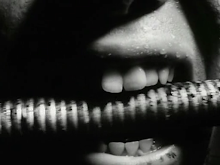
The infamy surrounding The Brown Bunny is something that will always define it. I remember the dark days surrounding the film’s premiere at Cannes, where actor/writer/director/director of photography/editor Vincent Gallo was criticized as misogynistic, narcissistic, artistically and morally misguided. Roger Ebert slammed the film, having allegedly made audible jokes during the screening (which was eventually booed by its conclusion).
Its controversial sex scene, involving graphic, questionably pornographic fellatio performed by Chloe Sevingy onto Gallo, brought up a debate about decency and art. Gallo’s control over almost every aspect of the movie made it seem like he had an agenda of his own, whether it be chauvinistic or intimately personal. I remember Gallo’s apologetic defense of the film, where he was hurt by the vile negativity of his critics, which made him recall harsh teasing in his youth for being “ugly.” The whole ordeal of the film’s wide panning at Cannes seemed like a nightmare and a day of reckoning for Gallo, who claimed he would never make a movie again.
But then he re-edited the film, got a great distribution deal, got some rave reviews and actually made money from it. Ebert himself gave the movie a “thumbs up.” For all its controversy and negative implications, The Brown Bunny somehow evolved into a legitimate, and even respected, cult film.
A complete contrast to the cinematic, inventive, densely dramatic Buffalo ’66, The Brown Bunny is stark, fragmented and aimless in structure. The movie opens with a long, shaky handheld shot of a motorcycle race which dissolves into the second-place loser Bud Clay (Gallo) recuperating and packing up. The DIY style, which feels like Gallo is the sole crew member behind, is reminiscent of Mario Van Peebles’ authoritative blaxploitation film Sweet Sweetback’s Baaadass Song. The ultra-minimalistic production values give the film a raw, truly independent energy like an inspired, experimental thesis student film. Probably half of the film is some kind of an interior car shot, which bridge a barely existing narrative about Bud’s lonely limbo of guilt and disbelief.
Gallo’s performance is strongly subtle, with his quiet voice and mousy presence effectively carrying out his character’s torturous inner existence. Because the film is guiltlessly indulgent, I started wondering how it would have played had Gallo cast another actor as Bud. To Gallo’s defense, he is pitch-perfect in the role to the point where casting anyone else seems pointless.
Although the movie is airy in dramatic substance, it is always compelling and never feels flimsy or gratuitous. For having a comparatively non-existent crew, the movie holds together well as a character study and a meditation on remorse. As far as the notorious ending, it is disturbing and shocking in a way that undoubtedly finalizes the narrative. The incestuous nature of sex in art is troubling in itself, but despite one’s possible moral objection to the material, the impact of the scene is appropriately troubling and consequently powerful.


No comments:
Post a Comment